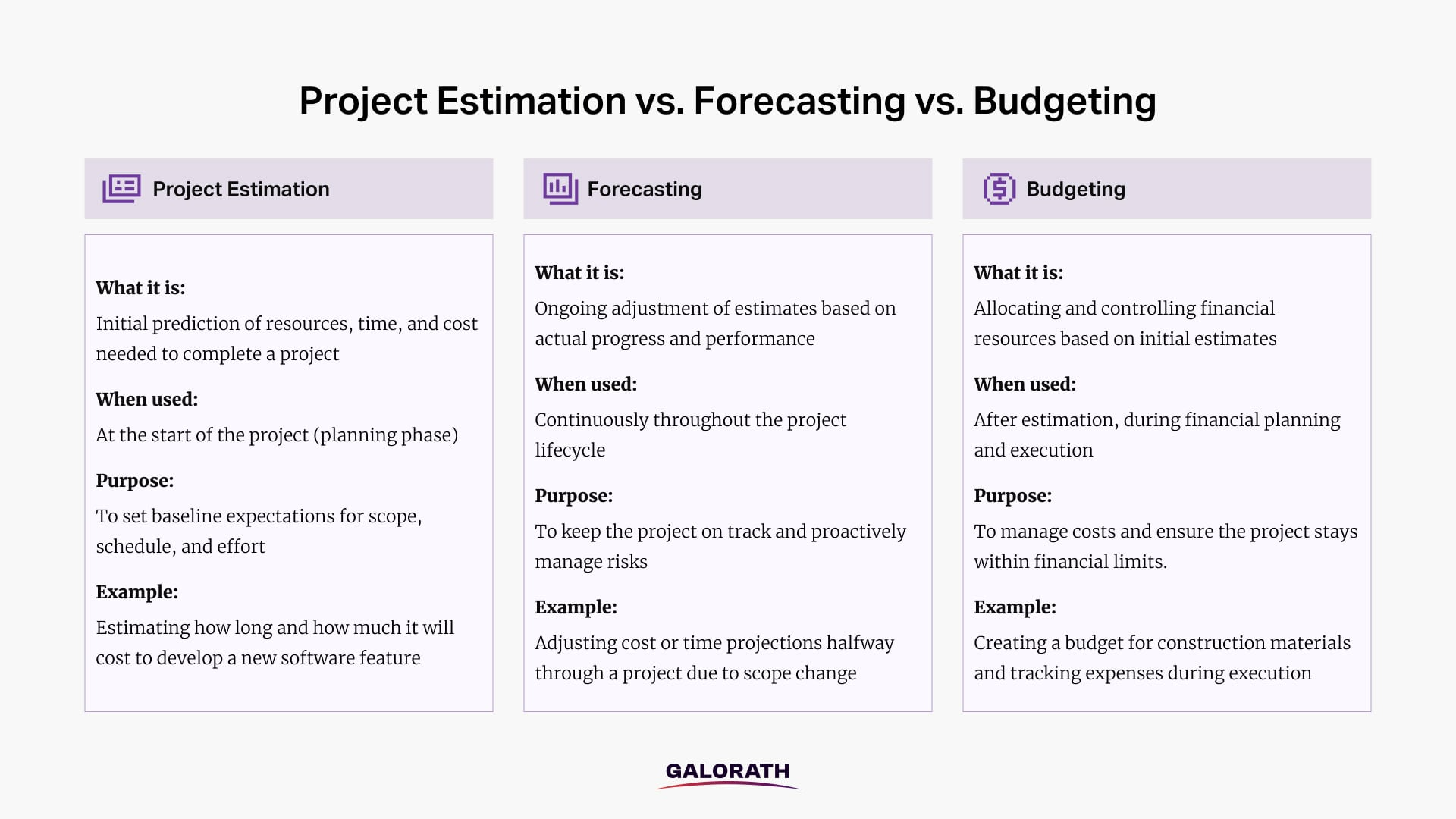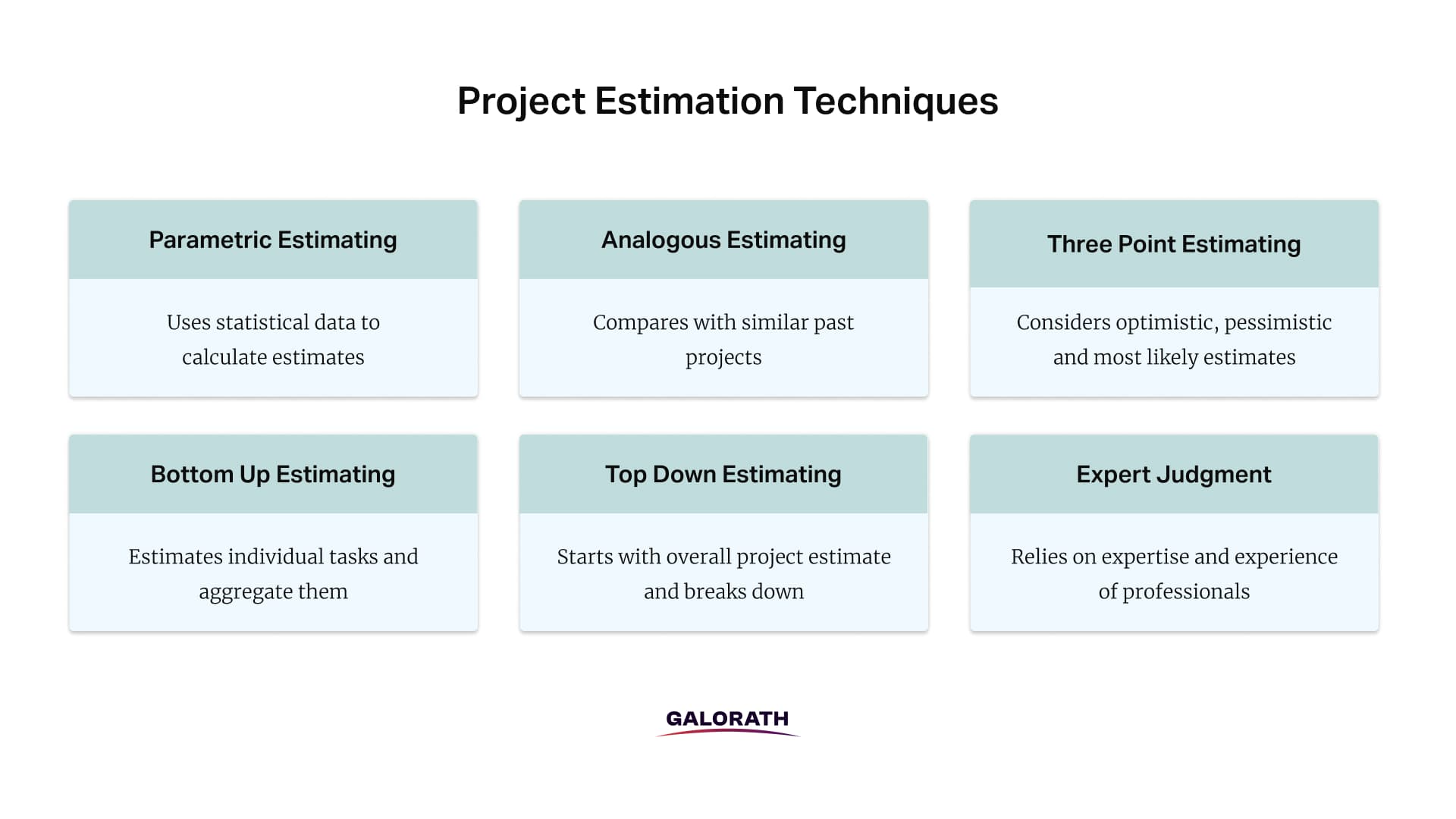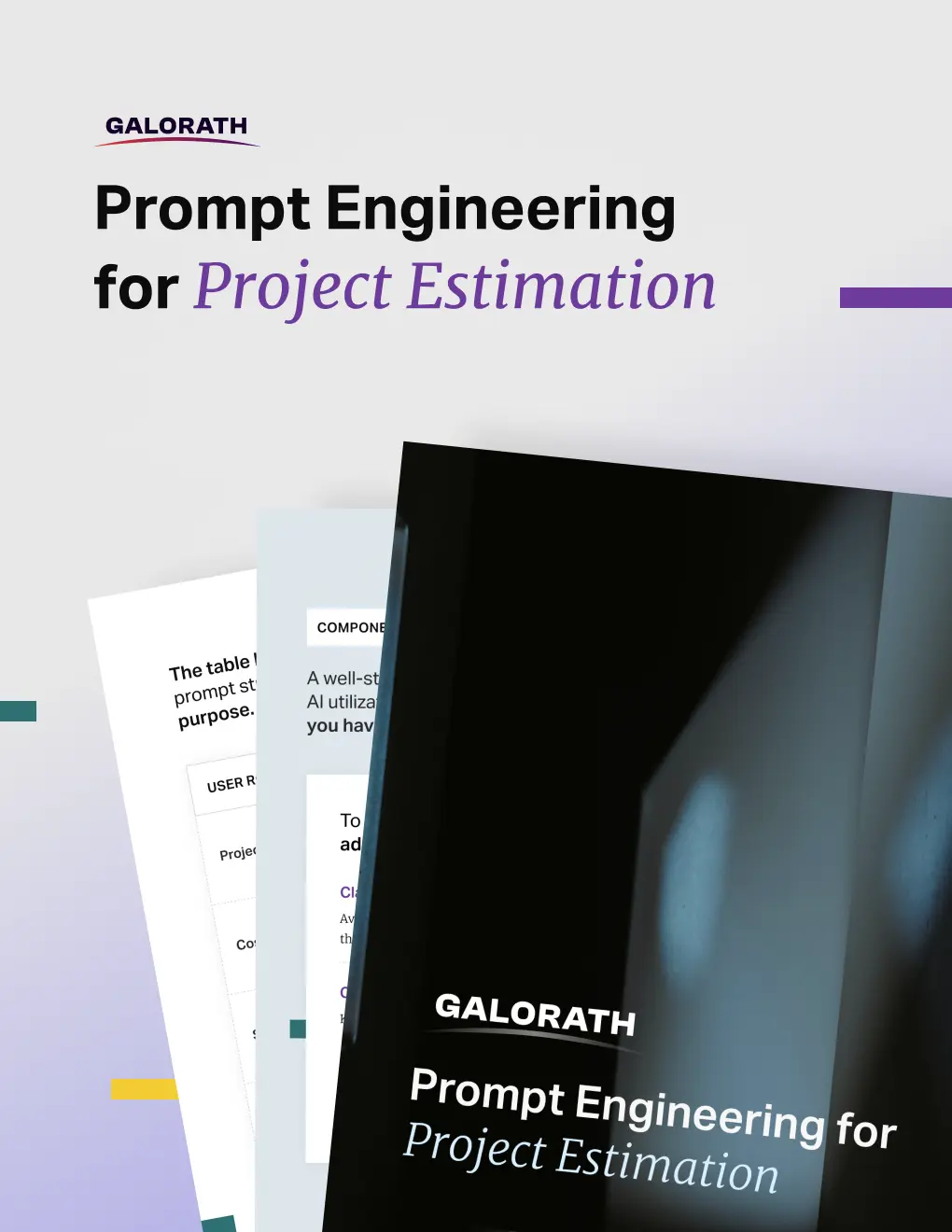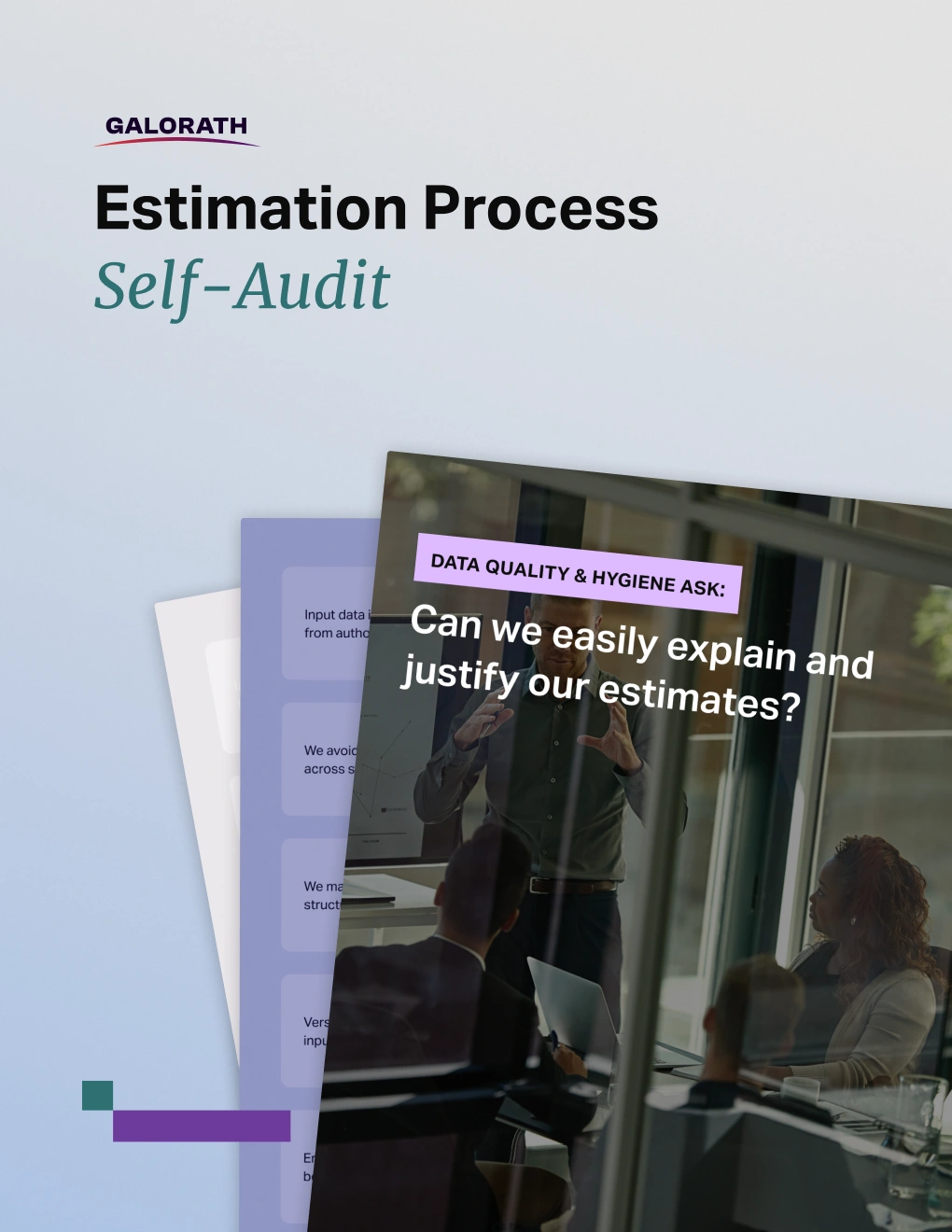Mastering Cost Risk with the CRED Model: A New Approach to Managing Uncertainty
Project estimation is considered a very important component of project management. It helps teams to predict the resources, time and costs for successful project completion. Accurate estimates help to enable risk management, cost management and effective resource allocation. This helps to ensure that projects stay on track. Project managers can align stakeholder expectations by using estimation techniques like analogous estimating, top down estimation and bottom up estimation. This also helps project managers to plan for potential challenges.
Estimating helps throughout the project lifecycle phases by forecasting project costs and minimizing the risks. Techniques like Monte Carlo simulation and Delphi technique offer advanced approaches to estimate with higher precision. In order to achieve project success it is essential to understand and apply the right estimation methods from cost estimation to effort estimation.
In this guide, we will explore the essential estimation elements like cost, time, scope, risk, resource( effort) and quality so project managers can select the best techniques for their projects.
What is Project Estimation?
Project estimation is the process of predicting project elements, such as resources, time and costs required to successfully complete a project. It plays a critical role in project planning, helping ensure that projects stay within scope, on time, and on budget.
Accurate project estimation provides the foundation for effective project planning and decision-making. Without reliable estimates, projects quickly veer off track, causing delays, budget overruns, and missed goals. This idea aligns with Piñeros Rodríguez thoughts in ‘Effort Estimation in Agile Software Development: A Systematic Map Study’, which emphasizes that “inaccurate estimates can significantly derail a project’s objectives.”
Across industries, the definition and approach to project estimation vary, but the underlying principle remains the same: it provides a clear picture of the resources and time needed to achieve the project’s objectives.
In IT and software development, project estimation often involves predicting the time needed to develop features, test products, and deploy software. Techniques like Agile estimation and Planning Poker, commonly serve this purpose. As Komala explains in ‘Innovative Cost Estimation for Agile Technology‘, “Planning Poker helps teams provide better estimates by encouraging diverse inputs, leading to more accurate and collaborative results”. Software projects often face complexities like changing requirements and technical uncertainties, making time and cost estimation even more critical.
In manufacturing, project estimation focuses on resource allocation, such as labor, materials, and machine hours. Accurate cost estimation determines labor costs, material expenses, and overheads, ensuring the project remains profitable. Rodríguez Sánchez explains that “decision tree techniques improve cost forecasting accuracy by accounting for uncertainties in manufacturing processes.”
In hardware development, cost and effort estimation relate to material procurement, assembly time, and testing. Estimators must also understand scope management thoroughly to anticipate potential risks and challenges during production. Estimating resources and time accurately in hardware projects is critical, especially in stages involving procurement and assembly, to prevent resource shortages.
Project estimation isn’t limited to just predicting time and cost; it also plays a vital role in risk management. An inaccurate estimate can result in overlooking potential risks, leading to project delays, additional costs, or even failure. As highlighted by the Standish Group in their Chaos Report, “The most successful projects were those with the most accurate estimates, particularly in terms of resource (effort) planning”.
What is the Difference Between Project Estimation, Forecasting, and Budgeting?
Project estimation, forecasting project costs, and budgeting are often used interchangeably, but they serve distinct roles in the project management process. Understanding their differences helps ensure that project managers can effectively plan, track, and adjust their projects to achieve successful outcomes.
Project Estimation
Project estimation refers to the initial prediction and it is a key element of the planning phase, where project managers create estimates for various aspects such as cost estimation, effort estimation, and time scheduling. These estimates are based on available information, historical data, and expert judgment. Estimation provides a starting point for project planning and defines the expected scope, timeline, and resources. As discussed in “Cost Estimation: Methods and Tools” written by Mislick & Nussbaum, “Accurate project estimation is essential for controlling project costs and ensuring successful completion.”
For example estimating the cost breakdown analysis for a software development project or predicting how long it will take to complete a specific phase of a manufacturing process. This concept is reinforced in ‘Factors that Influence Software Project Cost and Schedule Estimation’ written by Suliman & Kadoda, which explores how software project estimates impact overall project performance.
Project Forecasting
Forecasting is an ongoing process that updates the initial estimates based on actual performance and new data throughout the project lifecycle. Unlike project estimation, which is done at the beginning of the project, forecasting looks forward and adjusts predictions as the project progresses. It helps project managers track whether the project is on track with its initial estimates or if adjustments are needed to stay within budget, timeline, and scope. Forecasting allows for early identification of potential issues and enables proactive management of project risks. Khamooshi & Cioffi in “Uncertainty in Task Duration and Cost Estimates” explain that “forecasting helps manage uncertainties that may impact project timelines and project costs, ensuring accurate schedules and budgets.”
For example, forecasting project costs over time based on how much has been spent so far or predicting how changes in resource allocation may affect the project schedule. This approach is outlined in ‘A Review of Methods, Techniques and Tools for Project Planning and Control’, written by Pellerin & Perrier, which discusses how forecasting contributes to better project control.
Budgeting
Budgeting refers to the process of allocating and managing the financial resources required for the project. A project budget is created based on the project estimation, detailing the anticipated costs for each project phase or activity. Budgeting involves setting financial limits for the project and determining how to allocate resources to meet those limits. It is crucial for controlling cost management and ensuring the project does not exceed the financial constraints set at the outset. In “Cost Estimating: Methods and Tools” Mislick & Nussbaum suggests that “proper budgeting ensures that financial resources are used efficiently, maintaining project feasibility.”
For example, setting a budget for a construction project that includes costs for labor, materials, and overhead, and ensuring that the project stays within these limits by monitoring expenses as the project progresses. As emphasized in ‘Improving Project Budget Estimation Accuracy and Precision by Analyzing Reserves for Both Identified and Unidentified Risks’ by Kwon & Kang, accurate budgeting requires not only cost estimation but also managing risks effectively.

Key differences:
- Estimation is about predicting the initial resources, time, and costs based on limited data and expertise.
- Forecasting is an ongoing process that updates predictions based on actual performance and new data as the project progresses.
- Budgeting involves setting and managing the financial limits of the project, ensuring the project stays within the allocated budget throughout its lifecycle.
Why is it Important to Estimate a Project?
Estimating a project accurately is one of the most crucial tasks in project management, directly influencing the project’s success. An estimate forms the foundation of all project plans, ensuring that resources, time, and costs are properly allocated.
When estimations are done correctly, they lead to well-managed projects that meet deadlines, stay within budget, and achieve the intended objectives. There are many reasons that make it important to estimate a project.
1. Impact on ROI (Return on Investment)
Accurate project estimation ensures that resources are allocated efficiently, leading to a better return on investment (ROI). Without proper estimates, project managers may overspend or misallocate resources, ultimately diminishing the potential return.
By estimating project costs and timelines accurately, managers can better plan for profitability, allocate budgets effectively, and meet financial goals, leading to improved cost management and profitability.
In a software development project, having a precise cost breakdown analysis helps ensure that budget overruns don’t occur, which could reduce the overall ROI for the stakeholders. Kenneth E. Murphy and Steven John Simon from Florida International University, emphasize that “Accurate estimates provide the foundation for achieving the expected ROI in technology projects”
2. Meeting Deadlines and Scheduling
Project estimation is crucial for creating realistic schedules that meet deadlines. Time estimation and project scheduling help ensure that the right resources are available at the right time. If estimates are inaccurate, the project may experience delays that push deadlines and disrupt the overall timeline.
As Mario Vanhoucke explains, “A well-structured estimate allows project managers to allocate resources efficiently, keeping the project on track and within time constraints”.
Proper forecasting project timelines ensures that teams remain focused and avoid the last-minute rush that often leads to poor-quality deliverables. As Sheoraj and Sungkur state, “Effective forecasting allows teams to adjust expectations and allocate resources dynamically throughout the project lifecycle”.
3. Building Stakeholder Trust
Accurate project estimation is critical for maintaining stakeholder trust. Stakeholders-whether clients, investors, or internal teams-rely on project estimates to gauge the project’s feasibility and success. Misleading estimates can lead to distrust and undermine relationships with stakeholders.
Transparent and reliable estimates, on the other hand, show stakeholders that the project team is competent, organized, and capable of delivering results on time and within budget. As Zou & Zhang suggest, “Accurate estimates foster a trusting relationship between project stakeholders, as it signals the project’s feasibility and commitment”.
For example, in construction projects, accurately estimating the labor costs and project phases will help build trust with clients who expect to receive a clear financial and scheduling plan. This is in line with Zou & Zhang, who also explain that “Inaccurate cost estimates lead to dissatisfaction and a breakdown in stakeholder trust”.
4. Effective Resource Allocation
Accurate project estimation aids in the effective resource allocation. By predicting the effort estimation, resource allocation, and team expertise, project managers can ensure that the right people and tools are available when needed. Misestimating resources can result in overstaffing, underutilizing team members, or even running out of resources mid-project, leading to inefficiencies and delays. For instance, resource allocation in a manufacturing project can make sure the appropriate machinery is available, preventing production bottlenecks. As stated by Project Management Institute, accurate estimates ensure that all necessary resources are allocated efficiently, improving project management and the overall project success.
5. Risk Management and Mitigation
Accurate project estimates help identify potential risks early in the process. If estimates are off, it can lead to unforeseen issues, such as cost overruns or delays, which are often the result of underestimated risks. By estimating with precision, project managers can anticipate challenges, assess risk management strategies, and take proactive steps to mitigate these risks before they escalate.
For example, in hardware development, precise cost estimation using historical data allows for better identification of potential risks, such as material shortages, that could derail the project timeline. As stated by Schmidt & Richter, Accurate cost estimation is crucial in forecasting project costs, ensuring that budgets are adhered to, and that projects stay on track.
6. Improved Decision-Making
With accurate estimates in place, project managers are better equipped to make informed decisions. Estimates provide data that can be used to make trade-offs between scope, time, and cost.
Without reliable estimates, decision-making becomes guesswork, leading to suboptimal outcomes and project failure. In an IT project, estimating project time and the effort estimation required for each phase helps decide whether to adjust timelines or allocate additional resources to meet deadlines.
The use of precise project cost estimation enables better resource allocation and optimal project outcomes. Furthermore, estimating project budget can inform critical budget control strategies for ensuring financial sustainability throughout the project’s lifecycle.
Why is It Essential to Have a Precise Estimation?
Having a precise estimation is essential because it acts as the backbone for project planning, helps avoid potential pitfalls such as missed deadlines, budget overruns, and scope creep. A poor estimation, however, can severely impact a project’s success in several ways:
- Budget Overruns: Inaccurate cost estimates can lead to overspending, depleting resources and causing financial instability for the project.
- Missed Deadlines: Time estimation that doesn’t reflect reality leads to delays, which can cause reputational damage and stakeholder dissatisfaction.
- Scope Creep: Without a clear understanding of the project scope through accurate project scope breakdowns, teams may keep adding features or changes, increasing time and cost without corresponding benefits.
Who Estimates Projects and Their Size?
Projects are estimated by a variety of key stakeholders, such as project managers, estimators, SMEs and team members, who have specific expertise to ensure accurate predictions regarding time, cost, and resources. The responsibility for estimating projects and determining their size typically falls on a few key roles within the project team, each contributing unique insights based on their domain knowledge and experience.
1. Project Managers
Project managers are typically the primary estimators for a project. They oversee the entire estimation process, ensuring that the project’s scope, timeline, and costs are appropriately forecasted. Project managers leverage their experience with project management tools, risk management, and historical data to create realistic estimates. Their role is to integrate input from different team members and balance estimates against the project’s goals and constraints.
2. Subject Matter Experts (SMEs)
Subject matter experts provide critical insights during the estimation process. These experts have in-depth knowledge in specific areas of the project, such as software development, manufacturing, or engineering. For instance, in IT projects, developers and systems architects contribute to effort estimation for specific tasks like coding, testing, and system integration.
3. Team Members (Developers, Engineers, Designers, etc.)
Individual team members, such as developers, designers, and engineers, often provide input based on their expert judgment and experience with similar projects. Their estimates are essential for creating more granular, detailed predictions, particularly for tasks that fall within their specific areas of expertise. The team’s input is critical for resource allocation, task complexity alignment, and estimating realistic task durations.
4. Estimators or Cost Engineers
In larger projects, especially those in construction or manufacturing, cost estimators or cost engineers specialize in providing detailed cost estimates. They rely on industry standards, historical data, and specialized software tools to predict material costs, labor costs, and other expenses. Their work ensures that cost breakdown analysis is accurate and comprehensive.
5. Stakeholders and Clients
While not directly responsible for providing estimates, stakeholders and clients influence the estimation process by providing inputs regarding the project’s scope, budget constraints, and desired timelines. They help shape the project scope breakdown and set initial expectations, which guide the project team in providing realistic estimates.
6. External Consultants or Vendors
For specialized projects, external consultants or vendors may provide estimates based on their expertise. In cases where external technology, services, or materials are required, consultants can offer insight into resource allocation, effort estimation, and cost management based on their experience with similar projects.
When to Conduct Project Estimates in the Project Lifecycle?
Project estimates are crucial throughout the entire project lifecycle, with each phase benefiting from estimates that guide decision-making, resource allocation, and scheduling.
The purpose of project estimation evolves as the project progresses, helping project managers and teams navigate uncertainties, manage risks, and stay on track.
1. Project Initiation Phase
In the initiation phase, estimates are crucial for feasibility studies and defining the project scope. Early project estimation typically involves high-level estimates based on limited information. These estimates provide an initial idea of the time, cost, and resources needed to pursue the project, allowing stakeholders to make informed decisions about whether to proceed with the project.
The goal is to determine whether the project is worth pursuing by assessing potential costs and required effort. Early cost estimation and time estimation give an overview of the project’s viability.
2. Project Planning Phase
During the planning phase, project estimates become more refined and detailed. This is when the majority of the cost estimation, time estimation, and effort estimation take place. Work breakdown structures (WBS) are created, and detailed estimates are developed for each project task and milestone.
Detailed estimates help to create a project schedule, allocate resources, and set a realistic budget. Estimation in this phase helps develop the cost baseline and establish the project timeline. It is also essential for identifying risks and potential challenges in the project.
3. Project Execution Phase
In the execution phase, project estimates are used to monitor progress and manage resources. Although the initial estimates were created during the planning phase, ongoing forecasting is crucial in this stage. Project managers continually compare actual progress with the initial estimates to ensure the project stays on track and within budget.
Ongoing forecasting project costs and schedule tracking are essential for identifying potential issues and adjusting the project plan as necessary. Accurate estimates help maintain stakeholder trust and ensure the project stays aligned with its goals.
4. Project Monitoring and Controlling Phase
The monitoring and controlling phase overlaps with execution and ensures that the project is on track. Here, estimates are continuously updated through variance analysis-comparing actual performance with the initial estimates. This phase involves using detailed cost breakdown analysis and resource allocation adjustments to keep the project within scope, time, and budget.
Ongoing updates and comparison of actual performance to estimates allow for better risk management, quality control, and decision-making. If discrepancies are found, corrective actions can be taken to mitigate risks and prevent project failure.
5. Project Closing Phase
At the closing phase, estimates are used to compare planned outcomes against actual results, facilitating post-project evaluation. This phase provides valuable insights into the accuracy of initial estimates and helps identify areas for improvement in future projects.
The final estimates and actual data help with post-project evaluation and determining the overall success of the project. This phase is critical for capturing lessons learned regarding estimating project cost, schedule performance, and resource allocation.
6 Elements of Project Estimation
In project estimation, various elements are considered to ensure that a project is planned effectively and executed successfully. These elements provide a comprehensive view of what needs to be estimated and help project managers allocate resources, set timelines, and manage costs.

As seen in the image above, the six key elements of project estimation include Cost, Time (Schedule), Scope, Risk, Resource (Effort), and Quality. Let’s take a look at each element.
1. Cost
Cost estimation is one of the most critical elements in project planning. It involves forecasting the financial resources required for completing the project, including expenses for labor, materials, equipment, and overhead. Cost management ensures that the project stays within the allocated budget, preventing overspending and resource depletion. Accurate cost estimation helps avoid budget overruns and supports stakeholder trust by setting clear financial expectations.
2. Time (Schedule)
Time estimation focuses on predicting the amount of time required to complete a project or its individual tasks. It involves creating a realistic schedule that outlines the duration of each task, milestone, and phase. Schedule estimation is essential for managing deadlines and ensuring that the project progresses on time. Accurate time estimates allow for proper resource allocation and help maintain stakeholder confidence in meeting deadlines.
3. Scope
Scope estimation is the process of defining the specific deliverables, goals, and boundaries of the project. It helps project managers determine what is included and excluded from the project, ensuring clear expectations for both the team and stakeholders. Scope estimation also helps in identifying the resources and effort required to complete each deliverable.
4. Risk
Risk estimation involves identifying potential threats or uncertainties that could affect the project’s success. By assessing risks early, project managers can develop mitigation strategies to address issues before they become major problems. While risk management can be extensive, risk estimation helps in determining the likelihood and potential impact of risks, guiding proactive decision-making.
5. Resource (Effort)
Effort estimation focuses on determining the amount of labor, expertise, and other resources required to complete the project. This includes estimating the work hours needed for each task and assigning the appropriate resources based on their expert judgment and team expertise. Accurate effort estimation ensures that the project has sufficient resources to meet deadlines and produce high-quality results.
6. Quality
Quality estimation focuses on defining the standards and criteria for the quality of deliverables. It involves predicting the resources, time, and effort needed to meet the required quality levels for the project. Accurate quality estimation ensures that deliverables meet stakeholder expectations, comply with standards, and satisfy customer requirements.
What Are Project Estimation Techniques?
Project estimation techniques are the methods used by project managers to predict the resources, time, and costs required to successfully complete a project. These techniques have evolved over time to address the increasing complexity of projects and the need for more accuracy in predicting project outcomes.
Historically, project estimation was based on simple, experience-driven methods, but as the demand for precision grew, so did the variety of techniques available.
What are the main types of project estimation techniques?
The main types of project estimation techniques include parametric, analogous, three-point, bottom-up, top-down, and expert judgment, each suited to different project needs, levels of detail, and uncertainty. Those are referred as the traditional types of project estimation techniques and those are widely used across industries such as software development, IT and manufacturing, helping project managers plan effectively.
Parametric Estimating
Parametric estimating uses statistical relationships between historical data and project variables to predict project costs, duration, or resource requirements. It involves applying specific metrics, often called “parameters,” to a set of data to create a model that predicts project outcomes. These parameters might include cost per square foot, labor hours per unit, or time per deliverable.
How It Works:
In parametric estimating, project managers use historical data and known relationships to calculate the estimate. For example, if a company has completed similar construction projects, they can use data like “cost per square foot” to estimate the cost of a new building. This model works well when historical data is abundant and reliable.
In construction, using a cost per unit approach: if a project costs $100 per square foot, a 5000 square foot building would be estimated to cost $500,000.
Pros:
- High accuracy when solid historical data exists.
- Fast and efficient for large projects.
- Scalable to large and complex projects.
Cons:
- Accuracy heavily depends on the quality and relevance of historical data.
- Less effective for novel or unique projects with no historical data.
Analogous Estimating (Comparative)
Analogous estimating, also known as comparative estimating, involves using historical data from similar projects to estimate the costs, time, and resources of a new project. This method is based on expert judgment and previous experience with similar projects.
How It Works:
Analogous estimating technique involves reviewing past projects with similar scope and characteristics. By comparing these previous projects to the current one, estimators develop predictions. For example, if a similar software project took 3 months and $500,000 to complete, the estimator may predict similar timelines and budgets for the new project.
For example a software development team might use the cost and duration of a similar project to estimate the time and budget needed for a new software system.
Pros:
- Quick and easy to use.
- Ideal for projects with limited detailed information.
- Useful when historical data from similar projects is available.
- Promotes consistency across projects.
Cons:
- Less accurate than other methods, especially for projects with significant differences.
- Relies heavily on the experience of the estimator.
- Can lead to biased estimates if the prior projects are not truly comparable.
Three-Point Estimation
Three-point estimation is a technique that takes into account three different estimates for each project task or phase: an optimistic estimate, a pessimistic estimate, and a most likely estimate. These estimates are used to create a range or weighted average to account for uncertainty.
How It Works:
The optimistic estimate assumes everything goes right, the pessimistic estimate accounts for worst-case scenarios, and the most likely estimate reflects typical conditions. Three-point estimating technique is widely used to better handle uncertainty by providing a more comprehensive view of potential project outcomes.
To illustrate, a project manager might estimate a task duration to be 4 weeks (most likely), 6 weeks (pessimistic), or 2 weeks (optimistic). The weighted average can be used to calculate a final estimate.
Pros:
- Helps account for uncertainty and variability.
- Provides a range of possible outcomes, which helps in risk management.
- Offers a more balanced view of potential risks.
Cons:
- More time-consuming to gather multiple estimates for each task.
- Relies on subjective judgment, which may vary among team members.
Bottom-Up Estimating
Bottom-up estimating involves breaking down a project into smaller, more manageable components, and estimating the cost, time, or resources required for each of these smaller tasks. The estimates for each task are then rolled up to create an overall project estimate.
How It Works:
Bottom up estimating technique starts by identifying and detailing all the tasks that need to be completed. For each task, the estimator calculates the required time, cost, or resources. The sum of these individual estimates forms the total project estimate.
For instance, in software development, a project manager might break the project into modules such as user authentication, database integration, and front-end UI design. Each module is estimated separately in terms of developer hours, tools, and testing resources. These estimates are then aggregated to form the overall project cost and timeline.
Pros:
- Highly accurate since it is based on detailed analysis of each task.
- Provides better visibility into project components.
- Useful for complex or large projects with well-defined deliverables.
- Helps identify potential risks early through task-level analysis.
- Improves accountability by assigning estimates to specific tasks or team members.
Cons:
- Time-consuming and resource-intensive.
- May become overly detailed and complex for smaller projects.
- Can be challenging if tasks or deliverables are not clearly defined.
Top-Down Estimating
Top-down estimating is the opposite of bottom-up estimating. In this approach, estimates are made at a high level and then progressively broken down into more detailed estimates. Top down estimating involves creating an overall estimate based on general knowledge and experience, which is then refined as the project progresses.
How It Works:
The project manager or team leader provides a broad estimate based on prior knowledge or historical data. As the project progresses, this estimate is refined with more detailed information. It is often used in the early stages of a project.
For example, in software development, the project manager might estimate the total effort required for a project based on similar projects and then break this down into smaller components as the project scope is defined.
Pros:
- Quick and efficient for large, less-defined projects.
- Useful in the early stages when detailed information is not yet available.
- Provides a quick initial overview of project costs and timelines.
- Helps with early budgeting and resource planning.
- Encourages strategic thinking and big-picture focus.
Cons:
- Can lack accuracy due to the high-level nature of the estimates.
- Relies heavily on prior experience and general knowledge.
- May lead to unrealistic expectations if the top-level estimate is too optimistic or vague.
- Difficult to trace errors or discrepancies back to specific tasks.
Expert Judgment
Expert judgment involves using the insights and experience of subject matter experts (SMEs) to make estimates. These experts provide opinions based on their knowledge and past experience with similar projects.
How It Works:
In expert judgement, project managers consult with experts who have deep knowledge of the specific project domain. These experts provide estimates based on their professional judgment and historical data, often in combination with other estimation methods.
For instance, in construction, an experienced estimator may provide cost estimates for a project based on their knowledge of market trends, material costs, and labor availability.
Pros:
- Provides valuable insights from those with deep experience.
- Useful when limited data is available or when working on novel projects.
- Can be combined with other methods to improve accuracy.
Cons:
- Can be subjective, and the quality of estimates depends on the expertise of the individual.
- Potential bias or personal opinions can influence the outcome.
- Not as reliable when expert judgment is based on limited or outdated experience.
- May overlook unforeseen factors if experts rely too heavily on past experiences.

Exploring Advanced Project Estimation Techniques
While traditional project estimation techniques are essential, there are several complementary methods that provide more depth and flexibility in dealing with uncertainties. These advanced techniques allow project managers to gain a more nuanced understanding of potential outcomes and associated risks. Here are some of the key complementary estimation techniques:
Monte Carlo Simulation
Monte Carlo Simulation is a probabilistic technique that assesses the uncertainty and variability in project estimates by running multiple simulations. It uses random sampling and statistical modeling to predict a range of possible outcomes based on input variables.
Unlike traditional estimation methods, Monte Carlo Simulation provides a distribution of possible project results, allowing managers to quantify risk and uncertainty. According to F. M. Halil, Monte Carlo Simulation allows project managers to assess uncertainties and potential risks more effectively by running simulations of various scenarios.
Pros:
- Provides a more comprehensive view of risks by simulating different scenarios.
- Allows for the assessment of probabilities, helping managers make more informed decisions.
- Ideal for complex projects with multiple variables and dependencies.
- Helps identify the likelihood of meeting project deadlines and budgets.
- Improves communication of risks to stakeholders through visual probability distributions.
Cons:
- Requires significant data and computational resources.
- Can be too complex for small projects or those with limited resources.
- May result in overconfidence if the model is not designed or interpreted correctly.
What-If Analysis
What-If Analysis is a simple yet effective technique that allows project managers to explore various scenarios and their potential outcomes. By adjusting key variables, such as task durations, resource allocation, or costs, project managers can assess how changes impact the project.
This method helps identify risks early and make adjustments before problems arise. According toStefano Rizzi, What-If Analysis is a flexible and straightforward approach to understanding project risks by adjusting variables and exploring different scenarios.
Pros:
- Easy to understand and implement.
- Effective for risk identification and mitigation strategies.
- Provides flexibility to explore different possibilities in project planning.
Cons:
- Highly dependent on the quality and accuracy of input data.
- Can be subjective if scenarios are not defined clearly.
Delphi Technique
The Delphi Technique involves gathering input from a panel of experts, who provide estimates anonymously over multiple rounds. After each round, feedback is shared, and the experts revise their estimates until a consensus is reached.
This technique is particularly valuable when there is uncertainty, and expert opinions are crucial for making accurate estimations. According to R. Hacker, the Delphi Technique is an expert-driven consensus method used for complex projects with high uncertainty.
Pros:
- Promotes unbiased input from diverse experts.
- Builds consensus, leading to more reliable estimates.
- Well-suited for complex or uncertain projects where data is lacking.
- Reduces the influence of dominant individuals on the final estimate.
- Allows for iterative refinement, improving estimate accuracy over time.
Cons:
- Time-consuming, as it requires multiple rounds of feedback.
- Can be challenging to reach consensus when experts have conflicting opinions.
- The quality of the outcome depends heavily on the expertise of the panel.
Reserve Analysis
Reserve Analysis is used to account for uncertainties by adding contingency reserves to the project’s cost and schedule estimates. These reserves are set aside to address potential risks that could impact the project’s success.
Reserve Analysis ensures that unexpected events or uncertainties are adequately addressed, helping to maintain the project’s stability. Reserve Analysis is a method that adds contingencies to account for uncertainties in a project.
Pros:
- Provides a safety net for unforeseen risks.
- Helps ensure project stability by adding contingencies.
- Useful for projects with high uncertainty or a history of risk events.
Cons:
- Can lead to overestimation and unnecessary reserves if not properly managed.
- Excessive reserves may cause inefficiencies if they are not used.
- Not suitable for projects with predictable and low-risk outcomes.
- May encourage complacency if teams rely too heavily on reserves instead of risk mitigation.
- Difficult to determine the appropriate size of reserves without thorough risk analysis.
Ballpark Estimating
Ballpark Estimating is a rough approximation technique used in the early stages of a project when detailed information is scarce. It involves generating quick estimates based on historical data or broad assumptions from similar projects.
Although it is highly generalized, this technique is useful for determining the feasibility of a project or making initial decisions. According to M. Sharma, Ballpark Estimating provides a rough initial estimate based on broad assumptions.
- Pros:
- Quick and inexpensive to implement during the early stages.
- Provides a high-level view of project scope and feasibility.
- Helps prioritize projects or allocate resources before detailed estimates are available.
- Cons:
- Inherently inaccurate due to its reliance on assumptions and limited data.
- Cannot provide detailed insights needed for execution or monitoring.
- Not suitable for later stages of the project when more precise estimates are required.
- May lead to unrealistic expectations if stakeholders rely too heavily on rough estimates.
Agile Estimation Techniques
Agile estimation techniques are integral to the flexible and adaptive nature of Agile project management. These techniques emphasize continuous, iterative estimation, allowing teams to adjust their estimates as the project evolves. Unlike traditional estimation methods, Agile estimation focuses on maintaining flexibility in the face of change, ensuring that teams can respond to new information, shifting requirements, or evolving priorities. Agile estimation is especially useful in software development, where requirements are often unclear at the start and evolve over time.
In Agile, estimation occurs regularly in iterations or sprints, providing frequent opportunities to recalibrate and refine project forecasts. The primary purpose of Agile estimation is to improve the accuracy of predictions over time while allowing teams to be more responsive to changes. A key aspect of this process is Sprint Planning, where the team estimates the effort needed for tasks within a sprint. During this planning phase, Story Points are often used to estimate the relative effort involved in completing a user story or task, rather than using traditional time-based estimates. These estimations are crucial for planning and executing tasks in an Agile workflow, ensuring that teams can deliver value in a sustainable and predictable manner.
Agile Estimation Techniques, such as Sprint Planning and Story Points, are critical for iterative adjustments in Agile project management.
T-shirt Sizing
T-shirt sizing is an Agile estimation technique that uses categories such as Small, Medium, Large, and Extra Large (or sometimes more granular sizes like XS, S, M, L, XL, XXL) to estimate the relative size and effort of tasks or user stories.
The advantage of this method is its simplicity and ease of use. Teams quickly classify user stories into these categories based on the perceived complexity or effort required, rather than assigning specific numerical values.
Pros:
- Simple and quick to use, especially for high-level estimations.
- Easy to communicate with stakeholders, as the categories are intuitive.
Cons:
- Less precise than other methods like Story Points or Planning Poker, as it does not provide numerical estimates.
- Can be subjective, depending on the team’s interpretation of each size category.
- May not be suitable for very detailed or complex tasks where more precise estimations are needed.
Precision Comparison of Estimation Techniques
| Technique | Precision | Best For | Pros | Cons |
| Bottom-Up | High | Detailed projects with clear task breakdowns | Most accurate; task-level detail | Time-intensive; requires full scope clarity |
| Parametric | High | Projects with measurable units (e.g. cost/unit) | Scalable; consistent if data is solid | Needs reliable data; not fit for creative tasks |
| Three-Point | Moderate–High | Uncertain or high-risk projects | Accounts for risk; reduces estimate bias | Still based on expert assumptions |
| Top-Down | Moderate | High-level or fixed-scope planning | Fast; good for rough budgeting | Ignores task detail; less accurate |
| Analogous | Low–Moderate | Early-stage planning; limited data | Quick; uses past project data | Assumes close similarity; not very accurate |
| Expert Judgment | Varies | When expert input is the only source | Fast; useful when data is lacking | Subjective; prone to bias |
What’s the Most Precise Project Estimation Technique?
Bottom-Up Estimating is the most precise method when full project details are available. It breaks the project into individual tasks, estimating each one separately for maximum accuracy.
Parametric Estimating is also highly precise when reliable historical data and formulas are available. It works best for projects with quantifiable elements.
Choosing the Right Project Estimation Method
Each estimation technique offers unique strengths depending on your project’s needs:
- Highest Accuracy and Reliability:
- Bottom-Up Estimating: Ideal when detailed information is available; offers granular and precise estimates.
- Parametric Estimating: Uses statistical modeling, delivering highly accurate predictions based on historical data.
- Best for Managing Risk and Uncertainty:
- Three-Point Estimating: Provides estimates based on optimistic, pessimistic, and most likely scenarios, effectively highlighting potential risks.
- Three-Point Estimating: Provides estimates based on optimistic, pessimistic, and most likely scenarios, effectively highlighting potential risks.
- Quickest (But Least Accurate):
- Analogous Estimating: Quick estimates based on similar past projects; suitable when time is limited and precision is secondary.
- Top-Down Estimating: Fast, high-level approach, useful for initial estimates or feasibility studies.
- Most Dependent on Experience:
- Expert Judgment: Relies entirely on the knowledge and experience of experts, best used when historical data or structured methods aren’t available.
Key Challenges and Factors Affecting the Accuracy of Project Estimation
Project estimation is a critical process that plays a significant role in the success or failure of a project. However, several challenges and factors can influence the accuracy of project estimates. These challenges are often linked to uncertainties in project scope, resources, external factors, and the estimation techniques themselves. Below, we explore some of the most common obstacles that impact the precision and reliability of project estimates.
1. Inaccurate or Incomplete Requirements
One of the most common challenges in project estimation is incomplete or unclear project requirements. If the scope, objectives, or deliverables are not well-defined from the start, it becomes difficult to accurately estimate the resources, time, and costs required to complete the project. As project requirements evolve, these changes may lead to re-estimations and increased uncertainty.
Impact:
- Leads to scope creep and budget overruns
- Increases the likelihood of missed deadlines
- Causes confusion in task prioritisation, which may delay progress
- Results in miscommunication among stakeholders, leading to conflicting expectations
Solution:
- Engage stakeholders early to define clear, detailed project requirements.
- Use iterative estimation techniques to accommodate changes as they arise.
2. Lack of Historical Data or Previous Experience
Accurate project estimation often relies on historical data or past experience with similar projects. If a team lacks access to reliable data or has no previous experience with similar projects, they may struggle to make accurate predictions about timelines, costs, or resources. This is especially true in new or unique projects where benchmarks and past performance indicators are unavailable.
Impact:
- Results in overly optimistic or pessimistic estimates
- Leads to unrealistic project schedules and budgets
- Increases the risk of resource misallocation due to uncertain planning
- Causes difficulties in setting stakeholder expectations clearly
Solution:
To overcome the lack of historical data, teams can turn to industry standards or case studies from similar projects to guide their estimates. It also helps to involve experienced professionals by using techniques like expert judgment or the Delphi Technique, which gather valuable insights even when direct data is unavailable.
3. Uncertainty and Risk
All projects involve some level of uncertainty, and unforeseen risks can severely impact the accuracy of project estimates. These risks may arise from various sources, including technological challenges, external market forces, or resource constraints. Estimating the impact of these uncertainties can be difficult, leading to inaccurate or overly cautious estimates.
Impact:
- Can lead to underestimation of time and cost requirements
- Increases the likelihood of project delays or budget overruns
- Causes teams to either over-allocate or under-allocate resources
- Makes it difficult to maintain stakeholder confidence due to changing forecasts
Solution:
Incorporate risk analysis methods such as Monte Carlo Simulation or What-If Analysis to better quantify uncertainties and integrate them into your estimates. Alongside this, apply proactive risk management strategies to identify potential issues early and reduce their impact on the project.
4. Team Expertise and Skill Levels
The skill levels and experience of the project team play a significant role in project estimation. If team members lack the necessary expertise or are unfamiliar with specific tasks, their estimates may be less accurate. Overestimating or underestimating the time and effort required for tasks can affect the overall project timeline and cost.
Impact:
- Leads to poor task estimation and resource allocation
- May result in the project being under-resourced or overburdened
- Causes delays due to skill gaps or learning curves
- Increases the risk of quality issues if tasks are underestimated
Solution:
Focus on ongoing training and professional development to build team capabilities. Additionally, involve experienced team members in the estimation process, especially for complex or technical tasks, to improve accuracy and confidence.
5. External Dependencies and Changes
Projects often rely on external factors such as third-party vendors, suppliers, or regulatory approvals. Any delays or changes in these external elements can have a significant impact on project timelines and costs. These external dependencies are often difficult to estimate, especially when they are outside the control of the project team.
Impact:
- Can lead to delays in critical milestones
- Causes changes in the project scope and requirements
- Increases uncertainty around scheduling and budgeting
- May disrupt resource planning due to unpredictable external actions
Solution:
Develop contingency plans and include buffers in your schedule and budget to accommodate potential delays or changes from external sources. Maintain regular communication and monitoring of external stakeholders to anticipate issues early and reduce surprises.
6. Estimation Bias
Human bias can also affect the accuracy of project estimates. Common biases include optimism bias (overestimating the project’s ability to meet deadlines and budgets) and anchoring bias (relying too heavily on initial estimates without adjusting for new information). These biases can skew estimates and make them less reliable.
Impact:
- Results in overly optimistic or pessimistic estimates
- Can create unrealistic expectations among stakeholders
- Leads to resistance in adjusting estimates when new information arises
- May cause misallocation of resources based on skewed assumptions
Solution:
Adopt objective estimation methods like Planning Poker or Monte Carlo Simulation to minimise bias. Foster open team discussions and conduct multiple estimation rounds to surface and correct biased views.
7. Changing Project Scope (Scope Creep)
Scope creep occurs when new features or requirements are added to a project after the initial planning phase. This can significantly affect the accuracy of project estimates, as additional work can lead to higher costs and longer timelines. Without proper control, scope creep can derail a project and lead to continuous adjustments to estimates.
Impact:
- Causes delays and increases costs
- Makes it difficult to track progress and adhere to the original plan
- Leads to stakeholder frustration due to shifting priorities
- Creates challenges in resource allocation and workload balancing
Solution:
Establish strong scope management processes to control and approve changes carefully. Apply iterative estimation methods to regularly update estimates as the project scope evolves.
Can Project Estimates Be Wrong?
Yes, project estimates can be wrong. Project estimation is inherently uncertain, and many factors can lead to inaccuracies. The complexity of predicting the future of a project-such as unforeseen challenges, scope changes, or incomplete data-often results in estimates that do not accurately reflect the actual costs, timelines, or resources required.
Several reasons contribute to wrong project estimates:
- Inaccurate Requirements: If the project’s scope and requirements are unclear or incomplete at the start, it’s difficult to estimate the resources, time, and budget needed accurately. As new requirements arise or change throughout the project, the estimates need constant revision.
- Unforeseen Risks: Even with careful planning, unforeseen risks such as market changes, technology failures, or supply chain disruptions can occur, leading to incorrect estimates.
- Human Bias: Estimators may fall victim to cognitive biases like optimism bias, where they underestimate the time or resources needed, or anchoring bias, where they rely too heavily on initial estimates without adjusting for new information.
- Lack of Historical Data: Without reliable data from similar past projects, estimations tend to be based on assumptions rather than solid evidence. This lack of data can lead to overly optimistic or overly cautious estimates.
- Scope Creep: As the project progresses, additional requirements or changes to the scope often emerge, causing the original estimates to become outdated and inaccurate.
How to Choose the Right Estimation Technique for Your Project?
Choosing the right estimation technique for your project is critical to ensure accurate predictions and successful project delivery. The accuracy of your estimates will largely depend on various factors, including project complexity, the methodology you’re following, and the availability of reliable data and team expertise. If your estimates go wrong, as discussed earlier, it’s often due to one or more of these influencing factors. Below are the key considerations that will guide you in selecting the most appropriate estimation technique for your project.
Based on Project Complexity
The complexity of your project plays a pivotal role in selecting the right estimation technique. For simple projects with well-defined and predictable tasks, estimation techniques like T-shirt Sizing or Ballpark Estimating may be sufficient as they offer a high-level, quick approach to project planning.
However, for more complex projects, such as those with a high degree of uncertainty, intricate dependencies, or multiple stakeholders, techniques like Monte Carlo Simulation or Delphi Technique are better suited. These methods help account for variability and risk, providing a more detailed and accurate set of estimates.
- Simple Projects: T-shirt Sizing, Ballpark Estimating
- Complex Projects: Monte Carlo Simulation, Delphi Technique
Based on Methodology (Agile vs Waterfall)
The methodology you follow-Agile or Waterfall-will significantly influence the estimation techniques you choose. In Agile, estimation tends to be more iterative and continuous, with techniques like Planning Poker and Story Points being commonly used to estimate tasks for each sprint. These techniques are ideal for projects where requirements evolve over time, and flexibility is needed.
In contrast, Waterfall projects, which have a more linear and structured approach, benefit from techniques that provide clear, upfront estimates, such as Analogous Estimating or Critical Path Method (CPM). These techniques are well-suited for projects with a well-defined scope and minimal changes throughout the execution phase.
- Agile Projects: Planning Poker, Story Points, T-shirt Sizing
- Waterfall Projects: Analogous Estimating, CPM
Based on Data Availability and Team Experience
The availability of historical data and the experience of your project team can greatly impact the accuracy of your estimates. When data is abundant and the team has experience with similar projects, techniques such as Expert Judgment or Parametric Estimating are ideal because they leverage past performance to make more reliable predictions.
On the other hand, if data is scarce or if the team is unfamiliar with the project, methods like What-If Analysis or Delphi Technique-which rely more on expert input and consensus-are better suited.
- Abundant Data and Experienced Team: Parametric Estimating, Expert Judgment
- Limited Data and Less Experienced Team: What-If Analysis, Delphi Technique
Steps to Estimate a Project
Estimating a project involves a structured process to forecast time, costs, and resources required for successful completion. Below are the key steps to follow when estimating a project.
Step 1: Define the Project Scope
The first step in any project estimation is to clearly define the project scope. This includes identifying the project’s objectives, deliverables, key milestones, and resources required. A well-defined scope is critical to making accurate estimates, as it sets the foundation for the entire project plan.
Step 2: Identify Requirements and Resources
Once the scope is clear, the next step is to identify the requirements and resources needed to complete the project. This includes understanding both the technical and operational requirements, as well as determining what human resources, equipment, and materials are necessary. A detailed understanding of these requirements helps create more accurate estimates for time and cost.
Step 3: Break Down Tasks and Create a Work Breakdown Structure (WBS)
Next, break the project into smaller, manageable tasks using a Work Breakdown Structure (WBS). The WBS allows you to clearly define and organize the tasks that need to be completed. It ensures that no part of the project is overlooked and helps provide a detailed view of the work involved.
Step 4: Estimate Task Duration and Effort
With the WBS in place, estimate the duration and effort required for each task. Consider how long each task will take and the amount of resources needed. Estimation methods such as expert judgment or historical data can help improve the accuracy of these estimates. It’s important to also consider task dependencies when making these estimates.
Step 5: Develop the Schedule and Allocate Resources
Once you’ve estimated task durations and effort, allocate resources and develop the project schedule. Assign the right team members to each task based on their skills and availability. This step involves creating a timeline with milestones, deadlines, and task dependencies, ensuring that resources are balanced across the project.
Step 6: Identify Risks and Adjust Estimates
No project is without risk. At this stage, assess potential risks that could impact your estimates, such as changes in scope or unforeseen challenges. Adjust your estimates to account for these risks, either by adding contingency time or revising your resource allocation. Being proactive in risk management will help maintain the accuracy of your estimates.
Step 7: Review and Validate Estimates
Finally, review your estimates with the project team and stakeholders to ensure they are realistic and aligned with expectations. This step provides an opportunity to refine the estimates and make necessary adjustments. Validating the estimates with all involved parties helps ensure buy-in and sets clear expectations for the project’s execution.
Essential Practices for Accurate Project Estimation
Accurate project estimation is crucial to delivering successful projects on time and within budget. Following best practices can significantly enhance the reliability of your estimates and reduce the risk of project overruns. Below are essential practices to ensure effective project estimation.
1. Define Clear Project Scope and Objectives
Start by defining a clear and detailed project scope. Understanding the exact objectives, deliverables, and boundaries of the project allows for more accurate estimations. A well-defined project scope helps prevent scope creep and ensures that all necessary tasks are accounted for, improving project management accuracy.
2. Involve Stakeholders Early
Engage stakeholders early in the project estimation process. Their insights into project requirements, constraints, and expectations help shape accurate estimates. Continuous collaboration with stakeholders throughout the project will help ensure that project estimations remain aligned with evolving needs, making stakeholder expectations alignment crucial.
3. Use Historical Data and Benchmarking:
Leverage historical data from previous projects to improve the accuracy of your estimates. Project cost estimation and forecasting project costs are enhanced by using past performance, allowing you to predict more accurately how long similar tasks took, what resources were required, and potential risks. This context can guide more realistic estimates, especially for tasks with well-defined processes.
4. Break the Project into Manageable Tasks:
Breaking the project into smaller, manageable tasks using a Work Breakdown Structure (WBS) makes it easier to estimate individual components of the project. Project deliverables become clearer, and estimating smaller, discrete tasks rather than large, broad objectives reduces the likelihood of underestimating or overlooking critical elements like estimating project budget.
5. Choose the Right Estimation Technique:
Select the most appropriate project estimation technique based on your project’s characteristics. Techniques such as Expert Judgment, Analogous Estimating, and Monte Carlo Simulation are useful depending on the complexity of the project, the availability of historical data, and the degree of uncertainty. Choosing the right estimation technique ensures a more precise and realistic project estimation.
6. Incorporate Contingencies and Risks:
Always account for uncertainties and risks when estimating project costs, timelines, and resources. Add contingency reserves to account for unforeseen delays, scope changes, and risks that may arise. Risk management and continuous monitoring can help adjust project estimates as necessary throughout the project. Using techniques like forecasting project timelines can also aid in better understanding these uncertainties.
7. Collaborate with the Project Team:
Estimating project duration should be a collaborative process involving key project team members. Team members with experience in similar tasks can provide valuable input, helping to refine estimates. Collaborative estimation techniques, such as Planning Poker, can improve accuracy by drawing on collective expertise and perspectives.
8. Monitor Progress and Update Estimates Regularly:
Project estimates should not remain static. Regularly track the project’s progress and compare actual performance against the estimates. If discrepancies arise, update the estimates to reflect the new realities of the project. Monitoring project progress helps keep estimates aligned with actual performance, allowing for more accurate cost estimation.
9. Keep Communication Transparent:
Clear and transparent communication with stakeholders regarding the assumptions, risks, and uncertainties behind your estimates is essential. Transparency builds trust and ensures that all parties are aligned in expectations, making it easier to adjust plans if required. Regular updates ensure that everyone stays informed, reducing the impact of underestimating project budget.
10. Learn from Past Projects:
Once a project is completed, evaluate how accurate the project estimates were compared to the actual outcomes. Post-project evaluation is crucial in identifying lessons learned and using these insights to improve the estimation process for future projects. Continuously refining your approach based on past experiences leads to better estimates over time.









